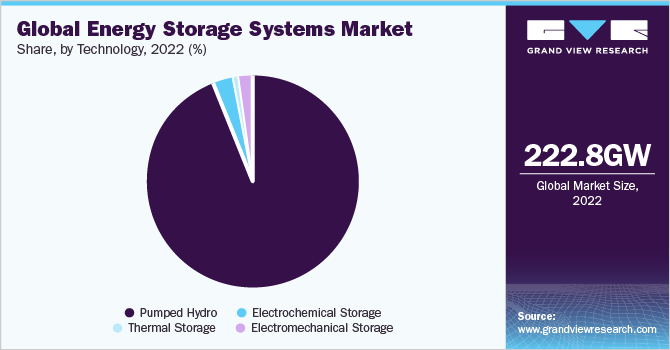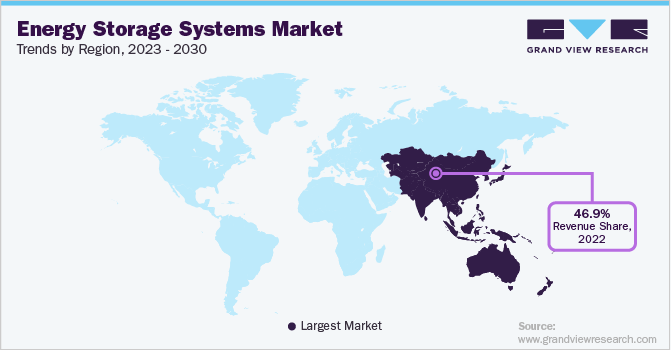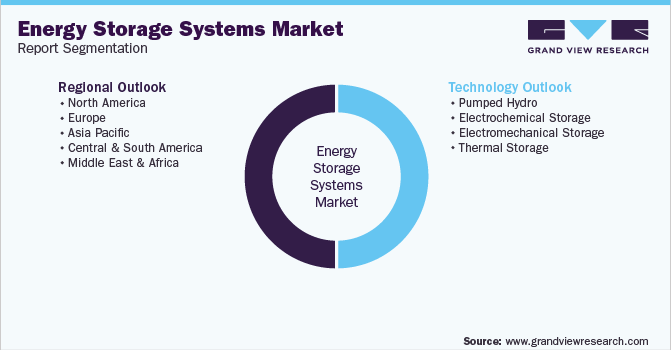- Home
- »
- Power Generation & Storage
- »
-
Energy Storage Systems Market Size & Share Report, 2030GVR Report cover
![Energy Storage Systems Market Size, Share & Trends Report]()
Energy Storage Systems Market (2023 - 2030) Size, Share & Trends Analysis Report By Technology (Pumped Storage, Electrochemical Storage, Electromechanical Storage, Thermal Storage), By Region, And Segment Forecasts
- Report ID: GVR-3-68038-057-6
- Number of Report Pages: 69
- Format: PDF
- Historical Range: 2018 - 2021
- Forecast Period: 2023 - 2030
- Industry: Energy & Power
- Report Summary
- Table of Contents
- Segmentation
- Methodology
- Download FREE Sample
-
Download Sample Report
Energy Storage Systems Market Summary
The global energy storage systems market recorded a demand was 222.79 GW in 2022 and is expected to reach 512.41 GW by 2030, growing at a CAGR of 11.6% from 2023 to 2030. Growing demand for efficient and competitive energy resources is likely to propel market growth over the coming years.
Key Market Trends & Insights
- The Asia Pacific was the largest segment in 2022 and accounted for more than 46.87% of the overall market share.
- Argentina is anticipated to see a significant slowdown in energy investment as the country emerges from its current recession in the coming years.
- On the basis of technology, the global market has been further divided into (Pumped Storage, Electrochemical Storage, Electromechanical Storage, Thermal Storage).
Market Size & Forecast
- 2022 Market Size: 222.79 GW
- 2030 Projected Market Size: 512.41 GW
- CAGR (2023-2030): 11.6%
- Asia Pacific: Largest market in 2022
Clean & renewable energy is an affordable alternative to fossil fuel-based electricity. Its use can help curb the overdependence on fossil fuels, reduce greenhouse gas emissions & subsequently air pollution, and diversify the power supply.The increasing number of data storage centers coupled with rapidly growing competition in numerous sectors including IT and finance is expected to augment the demand over the forecast period. In addition, changing consumer lifestyle and a rising number of power outages are projected to propel utilization in the residential sector.

Energy storage systems (ESS) in the U.S. was 27.57 GW in 2022 and is expected to reach 67.01 GW by 2030. The market is estimated to grow at a CAGR of 12.4% over the forecast period. The size of the energy storage industry in the U.S. will be driven by rising electrical applications and the adoption of rigorous energy efficiency standards. The industry's growth will be aided by a growing focus on lowering electricity costs, as well as the widespread use of renewable technology. According to the Institute for Energy Economics and Financial Analysis (IEEFA), in 2018, investments in renewable power production technologies, dominated by solar and wind energy, totaled USD 64.2 billion in the United States. Increased expenditures in the building of new power system networks, as well as ongoing measures to upgrade current distribution infrastructure, will support market growth in the U.S.
Technology Insights
On the basis of technology, the global market has been further divided into (Pumped Storage, Electrochemical Storage, Electromechanical Storage, Thermal Storage). The pumped hydro technology segment dominated the market and accounted for more than 94.59% of the total market share, in terms of storage volume, in 2022. The market is likely to be boosted by ongoing expenditures in the Asia Pacific and North America to upgrade energy infrastructure and increase on-grid capacity. Long-term demand for pumped hydro storage (PHS) is predicted to be driven by favorable compliance regulations and rising electricity consumption in China and the United States.

Over the next few years, countries such as the United Kingdom, the United States, and India are expected to drive electrochemical storage demand.Countries in the Middle East & Africa and Central & South America are expected to drive thermal storage demand over the long term.
Thermal Energy Storage (TES) systems gather and store surplus thermal energy generated by a variety of technologies for later use. Latent, sensible, and thermochemical TES systems are examples of several types of TES systems. Bricks, sand, water, rock beds, air, and concrete are some of the storage mediums employed in sensible heat storage.
Regional Insights
The Asia Pacific was the largest segment in 2022 and accounted for more than 46.87% of the overall market share, owing to the presence of fast-growing economies such as China and India.Energy storage devices are critical in applications such as UPS and data centers because this region is prone to frequent power outages. The ESS market in this region has been pushed by the benefits of modern energy storage systems, such as cost-effectiveness, environmental friendliness, and reliability.
The energy storage authorities in the aforementioned European countries have chosen battery energy storage technologies to expand the use of renewable energy sources while reducing reliance on fossil fuels. Long-term growth of the energy storage systems (ESS) market is likely to be aided by the growing popularity of electric vehicles in countries such as Germany and France.

For investments in the automotive, energy, and biochemical industries, Central and South America is a promising location. Brazil, Argentina, Peru, Colombia, and Chile are all important countries in the region. Argentina is anticipated to see a significant slowdown in energy investment as the country emerges from its current recession in the coming years. Countries in the Asia Pacific region are largely developing countries that are undergoing rapid industrialization.
Key Companies & Market Share Insights
The market is characterized by the presence of several key players and a few medium- and small-scale regional players. Many of the companies have their own sector that they focus on and have a very high penetration in that sector.For instance, In August 2021, Active Power announced planning a US road trip to bring its containerized POWERHOUSE UPS to user’s doorsteps. Under this strategic initiative, Active Power engineers will be partnering with sales and service partners to deliver a series of live demonstrations around the U.S. to exhibit the POWERHOUSE UPS. The U.S. tour will begin in October and is expected to run through 2022. Some of the prominent players operating in the global energy storage systems market include:
-
Altairnano
-
Ecoult
-
Electrovaya
-
GENERAL ELECTRIC
-
Langley Holdings plc
-
LG Chem
-
Maxwell Technologies, Inc.
-
Saft
-
Showa Denko Materials Co., Ltd.
-
The Furukawa Battery Co., Ltd.
-
Kokam
-
Fluence
-
Samsung SDI Co., Ltd.
Energy Storage Systems Market Report Scope
Report Attribute
Details
Market size in 2023
238.08 GW
Volume forecast in 2030
512.41 GW
Growth rate
CAGR of 11.6% from 2023 to 2030
Base year for estimation
2022
Historical data
2018 - 2021
Forecast period
2023 - 2030
Quantitative units
Volume in MW and CAGR from 2023 to 2030
Report coverage
Volume forecast, company ranking, competitive landscape, growth factors, and trends
Segments covered
Technology, region
Region scope
North America; Europe; Asia Pacific; Central & South America; Middle East & Africa
Country scope
U.S.; Canada; Mexico; Germany; U.K.; France; China; India; Japan; Argentina; South Africa
Key companies profiled
GENERAL ELECTRIC; LG Chem; Langley Holdings plc; Altairnano; Electrovaya; Showa Denko Materials Co., Ltd.; Maxwell Technologies, Inc.; Saft; The Furukawa Battery Co., Ltd.; Ecoult; Kokam; Fluence; Samsung SDI Co., Ltd.
Customization scope
Free report customization (equivalent up to 8 analyst’s working days) with purchase. Addition or alteration to country, regional, and segment scope.
Pricing and purchase options
Avail customized purchase options to meet your exact research needs. Explore purchase options
Global Energy Storage Systems Market Report Segmentation
This report forecasts revenue growth at global, regional, and country levels and provides an analysis of the latest industry trends in each of the sub-segments from 2018 to 2030. Forthis study, Grand View Research has segmented the global energy storage systems market report based on technology, and region:

-
Technology Outlook (Volume, MW, 2018 - 2030)
-
Pumped Storage
-
Electrochemical Storage
-
Electromechanical Storage
-
Thermal Storage
-
-
Regional Outlook (Volume, MW, 2018 - 2030)
-
North America
-
U.S.
-
Canada
-
Mexico
-
-
Europe
-
Germany
-
U.K.
-
France
-
-
Asia Pacific
-
China
-
India
-
Japan
-
-
Central & South America
-
Argentina
-
-
Middle East & Africa
-
South Africa
-
-
Frequently Asked Questions About This Report
b. The global energy storage systems market size was estimated at 222.79 GW in 2022 and is expected to reach 238.08 GW in 2023.
b. The global energy storage systems market is expected to witness a compound annual growth rate of 11.6% from 2023 to 2030 to reach 512.41 GW by 2030.
b. The pumped hydro segment accounted for a volume share of more than 94.59% in the global energy storage systems market in 2022. The segment accumulated the largest share due to its use in balancing of fluctuating output of intermittent renewable sources and baseload power plants.
b. Some key players operating in the energy storage systems market are GENERAL ELECTRIC, LG Chem, Langley Holdings Plc, Altairnano, Electrovaya, Showa Denko Materials Co., Ltd., Saft, THE FURUKAWA BATTERY CO., LTD., Ecoult, Kokam, Fluence, and Samsung SDI Co., Ltd.
b. Key factors driving the energy storage systems market growth include the increasing development of variable energy sources. Variable energy is fluctuating by nature due to frequent climate changes. Wind and solar power generation cannot be controlled like geothermal, biomass, and hydroelectricity.
Share this report with your colleague or friend.
Need a Tailored Report?
Customize this report to your needs — add regions, segments, or data points, with 20% free customization.

ISO 9001:2015 & 27001:2022 Certified
We are GDPR and CCPA compliant! Your transaction & personal information is safe and secure. For more details, please read our privacy policy.
Trusted market insights - try a free sample
See how our reports are structured and why industry leaders rely on Grand View Research. Get a free sample or ask us to tailor this report to your needs.










